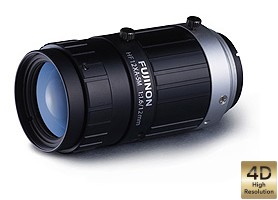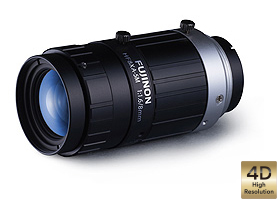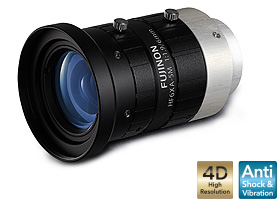HF50XA-5M
*Tipp : MPL Csomagautomata, Coop/Mol, és Házhozszállítás 1-2 munkanap,
Packeta Z-Pont / Z-Boksz 3-5 munkanap, valamint az átvételi pont helye is változhat túlterheltség esetén
Kategória: HF-XA-5M series
- Leírás
- HF50XA-5M PDFs
- HF-XA-5M Series
- HF-XA-5M Series PDFs
- Machine Vision Lenses Technical Terms
- Why people choose FUJINON lenses
Leírás
| Focal length [mm] | 50 |
| Iris range (F. no) | F2.4-F16 |
| Angle of view(2/3″) | 10.4°x7.8° |
| Working Distance*1[mm] | ∞‐200 |
| Operation of focus | Manual |
| Operation of iris | Manual |
| Filter thread [mm] | M30.5×0.5 |
| Mount | C-mount |
| Weight (approx.) [g] | 95 |
| Sensor size(std.)*2 | 2/3″(3.45μm) |
| Sensor size (max.)*3 | 1.1″(4.5μm) |
| TV distortion [%] | 0.01 |
| Dimension [mm] | φ33.0×66.5 |
- *1 From front of lens barrel
- *2 Sensor size(std.): Ideal size to maximize the target resolution
- *3 Sensor size(max.): Adaptable sensor size varies depending on the model. Select a lens after checking the peripheral light amount and resolution.
HF-XA-5M Series
„4D High Resolution” lenses
HF-XA-5M Series
Compatible with 2/3″ to 1.1″ (max.)
large image sensor cameras
FUJINON HF-XA-5M series is designed for „4DHR” and compatible with IMX250 high performance CMOS image sensor (2/3″, 5 megapixels, 3.45µm pixel pitch).
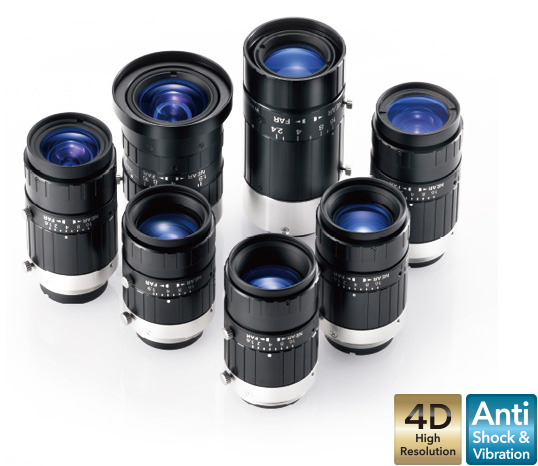
HF-XA-5M series specification sheet
| Model | Compatible format sizes | Focal length (mm) |
|||||||
| 4/3 | 1.1 | 1 | 1/1.2 | 2/3 | 1/1.8 | 1/2 | 1/3 | ||
| HF6XA-5M | - | - | - | - | ● | ● | ● | ● | 6 |
| HF8XA-5M | - | - | - | - | ● | ● | ● | ● | 8 |
| HF12XA-5M | - | - | - | ○ | ● | ● | ● | ● | 12 |
| HF16XA-5M | - | - | - | ○ | ● | ● | ● | ● | 16 |
| HF25XA-5M | - | - | - | ○ | ● | ● | ● | ● | 25 |
| HF35XA-5M | - | - | - | ○ | ● | ● | ● | ● | 35 |
| HF50XA-5M | - | ○ | ○ | ○ | ● | ● | ● | ● | 50 |
● Compatible sensor size (std.): Ideal size to maximize the target resolution.
○ Compatible sensor size (max.): Adaptable sensor size varies depending on the model. Select a lens after checking the peripheral light amount and resolution.
Main features
Minimizing degradation of resolution even when the shooting distance or aperture is changed
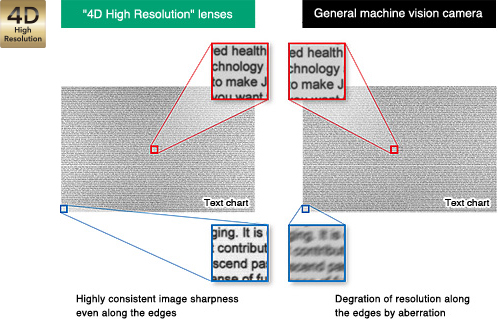
General machine vision camera lenses exhibit problematic degradation of resolution when the shooting distance or aperture is changed. FUJINON HF-XA-5M features high performance „4D HR” to minimize such degradation.
It maintains a highly consistent image sharpness from the center to the edges, while mitigating degradation of resolution caused by changes in the shooting distance or aperture. This enables consistent delivery of high-resolution images under a wide variety of installation and shooting conditions.
Anti-shock & vibration design
Our unique mechanical design* realizes anti-shock and vibration performance compatible with various installation environments.
- * Patent Pending
- * Only the HF6XA-5M and HF50XA-5M are equipped with Anti Shock & Vibration.
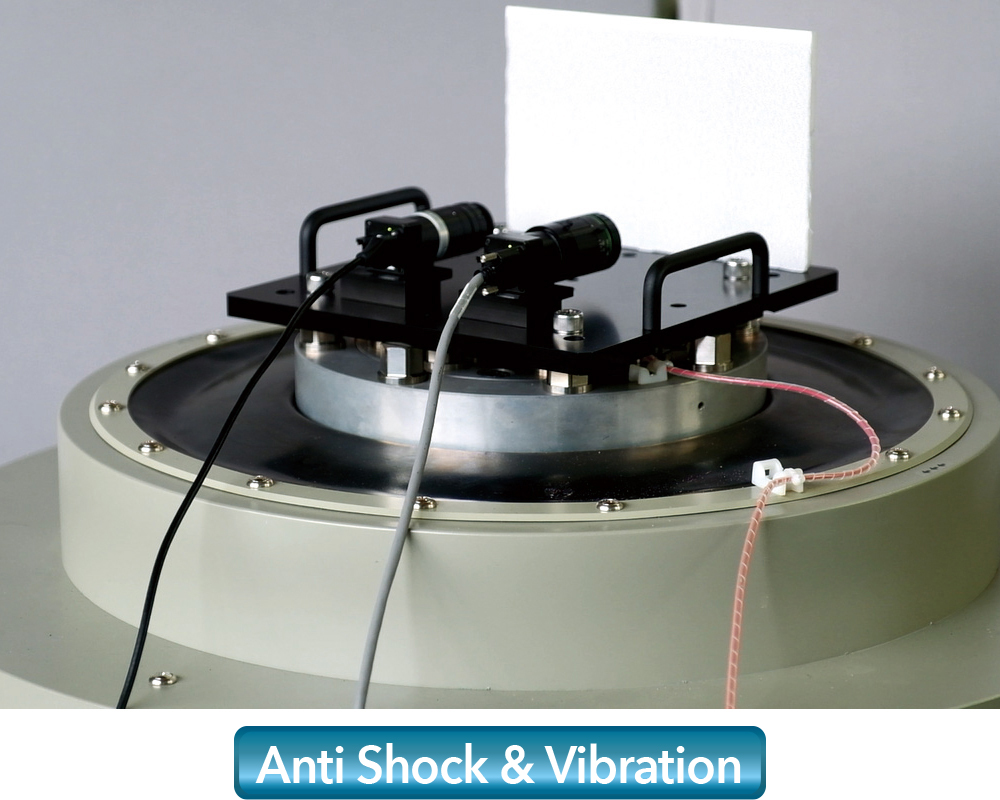
【Compliant with IEC60068-2-6】
- Vibration frequency of 10-60Hz (amplitude of 0.75mm), 60-500Hz (acceleration of 100m/S2)
- Sweep frequency of 50 cycles
Compact design

Despite being high resolution lenses, the HF-XA-5M series is the best for use with small machine vision cameras.
6mm:φ39mm
8mm/12mm/16mm/25mm/35mm:φ29.5mm
50mm:φ33mm
Selectable three locking holes
FUJINON HF-XA-5M series comes with three locking holes each for the iris and focus. They are located on the lens barrels, allowing you to select the optimum holes for your needs.
Machine Vision Lenses Technical Terms
Image Sizes
There are several types of imaging sensors for FA cameras, with different image sizes.The aspect ratio of FA camera is normally 4:3 (H:V).
| Product symbol | Image sensor | Image size (mm) | ||
|---|---|---|---|---|
| Horizontal :H | Vertical :V | Diagonal 😀 | ||
| C | 1” | 12.8 | 9.6 | 16.0 |
| H | 2/3” | 8.8 | 6.6 | 11.0 |
| D | 1/2” | 6.4 | 4.8 | 8.0 |
| 35mm camera lens (Reference) |
35mm Film | 36.0 | 24.0 | 43.3 |
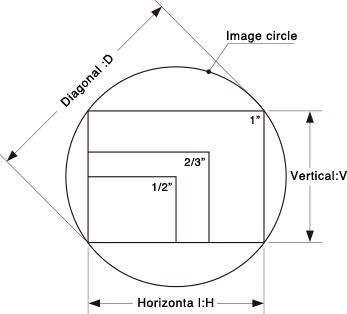
Angle of View
The angle of view is the object size that can be captured at a specified image size,
which is represented by angular measure. Normally the angle of view is measured assuming a lens is focused at infinity. When using a lens of the same focal length with a different image size, the angle of view will differ.

Eg. The angle of view when the camera size is 1/2″
and the focal length is 12.5mm:

Depth of Field
When focusing on a certain area in front of and behind the deep object appears in focus. This area is called the depth of field. This is because the focus appears sharp if the focus misalignment is under a certain volume. This certain volume is called the permissible circle of confusion.
The depth of field has following properties.
- 1)The larger the F No. is, the wider the depth of field becomes.
- 2)The shorter the focal length is, the wider the depth of field becomes.
- 3)The longer the distance to the object is, the wider depth of field becomes.
- 4)The backward depth of field is wider than the forward depth of field.
| Image sensor | Permissible circle of confusion |
|---|---|
| 1” | 0.03 mm |
| 2/3” | 0.021 mm |
| 1/2” | 0.015 mm |
| 1/3” | 0.011 mm |
| 1/4” | 0.008 mm |
The depth of field can be calculated by the following formula


Depth of field =
Tr+Tf
Focal depth =
2δ・F
f : Focal distance
F : F No.
δ : Permissible circle diameter of confusion
L : Object distance

Focal Length
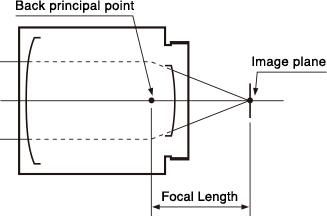
The focal length will be the distance from the back principal point to the image plane.
Lower the focal length wider the image
Brightness of a Lens (F No.)
The F No. is an indication of the brightness of lens. The smaller the value, the brighter the image produced by the lens. The F No. is inversely proportional to the effective diameter of the lens and directly proportional to the focal length.
The F No. is a value determined on the assumption that the transmittance of the lens is 100%.
Virtually all lenses however, have different spectral transmittance, and thus, the same F No. can have different levels of brightness.

Field of View and Focal Length

(1) How to calculate the field of view
If the distance to the object is finite, you can use the following formula to calculate the field of view.

Eg. 1/3″ CCD camera with an 8mm lens is used, and the distance to the object is 3m. The maximum horizontal width as viewed on the monitor can be calculated as follows.
- Y’: 4.8
- L: 3000
- f: 8

(2) How to calculate focal length
If the distance to the object is finite, you can use the following formula to calculate the focal length.

Eg.1/3″ CCD camera with an 8mm lens is used, and the distance to the object is 3m. The maximum horizontal width as viewed on the monitor can be calculated as follows.
- Y’: 4.8
- L: 3000
- f: 8
Distortion
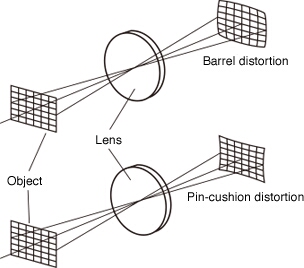
Distortion is an aberration where the geometric figure of the object is not reproduced faithfully at the image plane. It is normally represented by the level shift of an image point from its ideal position by a percentage of image height or width.
MTF (Modulation Transfer Function)
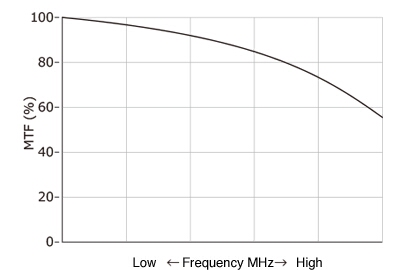
MTF (Modulation Transfer Function) represents the declining contrast rate when shooting a chart consisted of black and white lines.
Why people choose FUJINON lenses
Why people choose FUJINON lenses
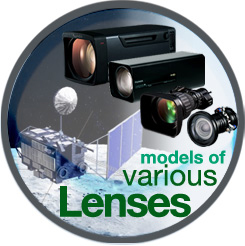
A wide range of product categories
Fujifilm is the only comprehensive lens manufacturer handling lenses in a wide range of sizes, materials and shapes from large to super small aperture lenses, lenses for 8K and 4K high-definition TV broadcasting, interchangeable lenses and cinema lenses for digital cameras loved by professional photographers and creators all over the world, high brightness lenses for digital cinema projectors and small lenses for in-vehicle cameras. All lenses boast high performance and quality recognized by professionals. The FUJINON brand has won the Engineering Emmy Award several times in the past, which is one of the most prestigious awards in the broadcasting industry along with the Academy Award. The high quality undergirded by our technology has been highly recognized worldwide.

Advanced technologies accumulated in the course of more than 80 years in the business
The history of Fujifilm’s lens manufacturing started in 1940 when it succeeded in the dissolution of 12 kinds of optical glasses. Manufacturing of high precision lenses requires expertise. Fujifilm has accumulated advanced technologies over the course of almost 80 years and it continues to provide numerous products that lead the world utilizing its manufacturing, processing, assembly and other technologies.

Global network
With sales/production bases in more than 30 countries worldwide, Fujifilm develops its logistic marketing from a global perspective and provides quick and carefully tailored local services at each base.

More than 1.1 million Machine Vision Lenses have been produced
The total produced number of FUJINON Machine Vision Lenses has reached more than 1.1 million, while technologically evolving the entire time. Fujifilm lenses manufactured by bringing together Fujifilm’s state-of-the-art technologies are used at production and quality inspection sites all around the world. Fujifilm continues to address customer needs with a variety of products that deliver consistent high resolution performance in a wide range of installation environments.
FUJINON lenses’ unique “4D High Resolution” performance
„4D High Resolution” is high resolution performance unique to FUJINON lenses. It maintains a highly consistent image sharpness from the center to the edges, while mitigating degradation of resolution caused by changes in the shooting distance or aperture. This enables consistent delivery of high-resolution images under a wide variety of installation and shooting conditions.

1.Floating design technology
Degradation of resolution can be minimized even when the shooting distance is changed
- The lenses are designed to show the best resolution at the shooting distance most commonly used (designed distance). At this distance, the aberrations (color fringe/peripheral blur/distortion) are ideally corrected.
- Although conventional lens design technology optimally controlled aberration at the designed distance,
aberration occurred at other distances and lowered resolution. The wide angle lens in particular had issues with its tendency for curvature of field (peripheral blur).
- The HF-12M series has implemented “floating design technology”. “Floating lens elements” behind the iris move to focus and enable the HF-12M series to retain its highest resolution regardless of the shooting distance.

2.Eccentricity adjustment technology
Retaining consistent resolution to the periphery of the image
- Misalignment of the axis of the lenses during the manufacturing process prevents the intended performance from being exhibited. It is crucial to align the axis of the lenses to the micrometer level during its manufacturing process.
- The HF-12M series realized high-resolution consistent all the way to the periphery of the image. This is accomplished by detecting all lens core misalignment using proprietary inspection equipment of Fujifilm manufacturing technology and aligning the whole lens constructions with micrometer level adjustments.

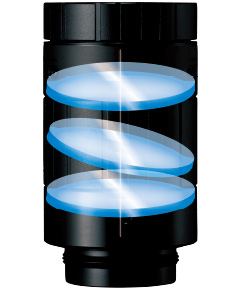
No misalignments
Lenses are misaligned
„4D High Resolution” lenses
General machine vision camera
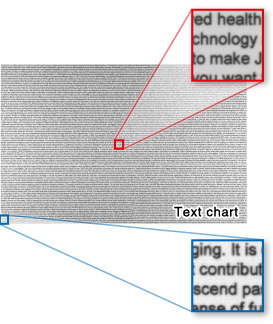
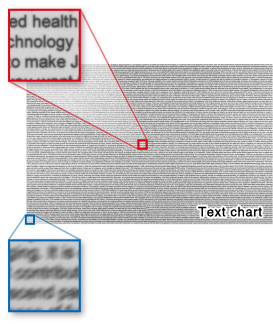
Highly consistent image sharpness even along the edges.
Aberration degrades the resolution along the edges
- Fujifilm’s proprietary manufacturing technology is utilized by applying the precision technology needed for manufacturing broadcast lenses that require high-dimensional and consistent qualities, to the manufacturer of miniature lenses such as camera modules for mobile phones.
-
Glass matching technology (Fujifilm original optical design software “FOCUS”)
Controls the drop in resolution caused by changing aperture value
- “Lateral chromatic aberration (color fringe)” is the main cause for the drop in resolution when changing the aperture value. Due to the different refractive index of the wavelength, imaging position sometimes differs by colors. This leads to the color fringing at the edge of the frame. To control of this aberration combination of the glass materials matters. While general glass materials can correct only the 2 colors of RGB(Red, Green, Blue), Extra-low Dispersion glass material enables the correction of all three colors at high level.
- By implementing glass with Extra-low Dispersion characteristics to control lateral chromatic aberration, the HF-12M series have succeeded to maintain the high resolution even when changing the aperture value.
- Fujifilm’s has developed its original lens design software “FOCUS (Fujifilm Optical Class Library and Utilities System)”, which enables to decide the best glass materials from the infinite combination of possibilities.

- * Simulated image
„4D High Resolution”
This video explains FUJINON lenses’ unique „4D High Resolution” performance.
FUJINON Anti Shock and Vibration
1.Optical axis shift (image deviation) can be suppressed to 10um or less.
- In the case of ordinary machine vision lenses, the optical axis shift occurs when shock moves lenses from their initial position and it affects the lenses ability to provide highly precise measurement.
Fujifilm’s unique mechanical design*1 paired with FUJINON Anti-Shock performance suppresses the optical axis shift less than 10um*2 even when shock up to 10G*3 is present.
- *1 Patent applied for
- *2 Maximum impact tolerance varies by model
- *3 Measured results by Fujifilm
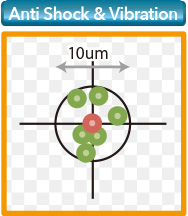
Optical axis shift (image deviation) can be suppressed to less than 10um*3 even when shock up to 10G*2 is present.

Axis shift when given repeated shocks
-
Can be used in environments with harsh vibrations.
- The ordinary machine vision lenses have problems of toughness under working environment where vibration occurs.
FUJINON Anti-Vibration performance has passed vibration test conforming to IEC60068-2-6. This feature helps to keep both the mechanical and optical elements in their original position while maintaining superb resolution.
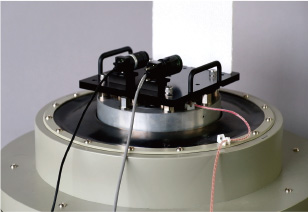
【Compliant with IEC60068-2-6】
・ Vibration frequency of 10-60Hz (amplitude of 0.75mm),
60-500Hz (acceleration of 100m/S2)
・ Sweep frequency of 50 cycles
3.Suppresses aged deterioration and provides advanced installation convenience.
- Fujifilm original mechanical design minimizes the use of adhesive to avoid aged deterioration that can be caused by humidity and heat in the production line.
- The variable throttle mechanism does not require iris parts to be changed and allows easier installation.
Anti Shock & Vibration / function
The video explains the anti-shock and vibration function, suppression of age deterioration, and our pursuit of ease-of-installation.

High-precision glass mold aspherical lens technology
Achieving both miniaturization and low distortion
- In lens design, reducing the number of lenses and forming an image by abruptly bending light that enters the lens achieves miniaturization. Distortion cannot be controlled if the lenses are only composed of the commonly used spherical lens. However, the aspherical lens can yield the same results of using multiple spherical lenses, enabling the control of distortion with far fewer lenses.
- Aspherical lenses require precision processing. Fujifilm can design and manufacturer aspherical lens within its own group. The precision processing required in the design stage and its mass production is realized by accurate die machining technology.
- The HF-12M series realizes both miniaturization and low distortion by implementing the high-precision glass mold aspherical lenses.
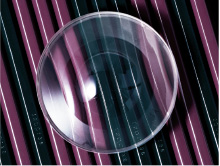
MV lens with an aspherical lens
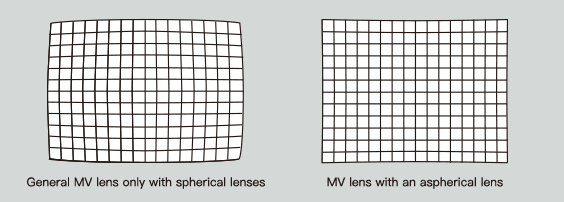
* Simulated image.





